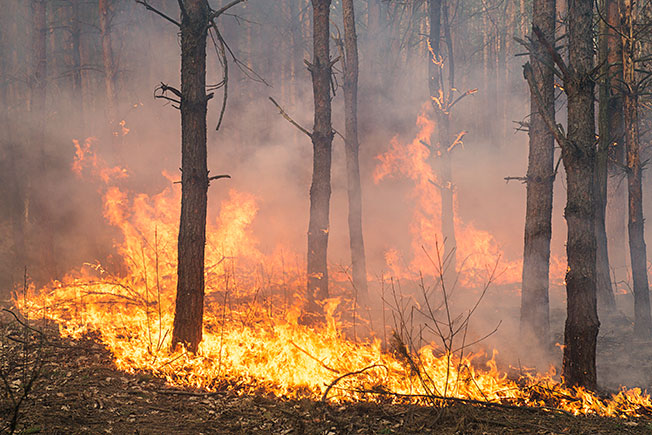What is Mass Evacuation Insurance and How Does It Work?

Wildfires are on the rise in Canada. Western provinces including B.C. and Alberta are expected to see longer and more intense wildfire seasons in the coming years. As wildfires worsen, more families in Western Canada and across the country will need to consider Mass Evacuation coverage if they do not already have it.
Mass Evacuation insurance is part of most home insurance policies and is meant to cover the financial burden placed on you and your family during a mass evacuation. Mass evacuation orders may be put in place by governments during wildfires, tornadoes, floods, or other natural disasters. This guide to Mass Evacuation insurance will focus mainly on evacuations due to wildfires.
What Is Mass Evacuation?
Understanding mass evacuation orders and having an emergency plan could save your life when you live in a wildfire zone. Devastating wildfires in recent years have shown how quickly you need to move when there’s a natural disaster. You don’t have time to stop and worry about your insurance when you need to leave your home, but you will have some peace of mind knowing that your policy should help you cover the unprecedented expenses.
One of the most important things you can do for your family’s safety is to have an emergency plan in place. Find more information on emergency preparedness with the Red Cross. Keep reading below to learn about the stages and types of evacuation orders, followed by a breakdown of how fire insurance coverage works if your home is damaged.
The 3 Stages of an Evacuation
There are three stages of Mass Evacuation that you should be aware of so that you know how to respond to government orders.
#1 Evacuation Alert: There is a growing risk that your area will need to be evacuated, and you should be ready to leave on short notice. This is a good opportunity to review your emergency plan, get your emergency kit ready, and make a plan for shelter in case you do have to leave.
Don’t forget to gather clothes, important paperwork, toiletries, medication, and anything you don’t already have in your grab-and-go bags.
#2 Evacuation Order: You should leave the area immediately. Your area is in imminent danger, and you should follow the directions of local emergency officials. Use designated evacuation routes identified by authorities and do not return until the order is lifted.
#3 Evacuation Rescinded: The final stage is when local authorities determine that the area is safe once again. The evacuation order will be rescinded and you can return. This is when your emergency evacuation insurance no longer covers your costs. If there are additional expenses as a result of damage to your home after a mass evacuation order has been lifted, those are covered by ordinary fire insurance claims.
Now is your opportunity to investigate the damage, if there is any. Continue to pay attention to the situation and wait for local alerts.
Types of Evacuation
There are different types of evacuation, though not all of them will lead to a Mass Evacuation insurance claim.
Urgent
In an urgent evacuation, you don’t have time to prepare. This is why it’s important to have grab-and-go bags ready at all times and why it’s essential to talk to your kids about emergency preparedness and your plan. Wildfires can spread at alarming speeds. In Lytton, B.C., residents had only 15 minutes to gather their belongings and flee.
Planned
In a planned evacuation, you have more time to prepare. Use that time so that you’re not caught off-guard if and when you do have to leave. Use the opportunity to review your evacuation plan and see if you can find accommodations. In an emergency, there is often a shortage of hotel rooms in the surrounding area, but if you can find one, those costs should be reimbursed through Mass Evacuation insurance.
Shelter-in-Place
A shelter-in-place order is not quite the opposite of an evacuation. It’s a response to a danger outside but not one that will destroy your home. If there are wildfires nearby but not threatening your town, it could be an air quality threat as a result of the fires. The idea of shelter-in-place during a wildfire is to limit your exposure to dangerous particulate matter. In addition to remaining indoors, you should:
- Close and lock all exterior doors and windows, and seal cracks with duct tape.
- Turn off fans, air conditioning, heating, etc. to avoid pulling air into your home.
- Move to an interior room on the ground level.
- Close the damper if you have a fireplace.
A shelter-in-place order may also be issued to protect you from tornadoes and other extreme weather events.
Building Evacuation
Every time you participate in a fire drill, you’re practicing building evacuation. Building evacuation is limited to a single structure, requiring everyone to vacate the structure and find safety outdoors. A building evacuation is not a type of mass evacuation, even if a large number of people are involved (i.e., in an apartment building or an office). Emergency evacuation insurance does not come into play unless a mass evacuation order has been issued.
In the event that your condo or apartment building is damaged in a fire, you can rely on coverage for Additional Living Expenses in your policy for shelter and other costs while you wait for repairs to be made.
Can I Get Reimbursed for Evacuation Expenses?
Mass Evacuation insurance covers sudden expenses due to natural disasters and industrial accidents that require the evacuation of your neighbourhood or town. These are some of the things that are most likely covered by your insurance during a mass evacuation:
- Temporary accommodations (short-term during the evacuation).
- Food above your usual expenses (i.e., the difference between ordering takeout and your grocery bill because you do not have access to a kitchen).
- Travel costs above your usual expenditure.
Mass Evacuation insurance coverage is only used for expenditures above and beyond your usual expenses. For example, if you usually pay $1,200 a month in rent or on home payments, that works out to about $40 a day. The average cost of a hotel room in British Columbia is $87 a night, and you may need more than one room for your whole family. Mass Evacuation insurance coverage pays the difference, minus a deductible and up to a certain limit.
How Insurance Can Help You in a Mass Evacuation
Your insurance policy is in place to help you recover financially after a loss. In a wildfire, you can lose everything in a matter of minutes. But when there’s no time to salvage your belongings, it’s easier to leave things behind when you know that your insurance will help. But your policy can also help you cover the costs of evacuating itself.
When an evacuation order affects your home, mass evacuation insurance will reimburse you for extra costs incurred during the order. After that time, Mass Evacuation Coverage will terminate.
If, after the order is lifted, you discover that your home was damaged to the extent that it is no longer livable, you will have to inform your insurance company. Additional Living Expense coverage will then kick in and reimburse you for temporary accommodation until your home is in livable condition.
In addition to the costs associated with not being able to live in your home, your home insurance policy will also cover the replacement or restoration of your personal belongings, as well as rebuilding the structure of your home.
If your home was not damaged, or if the damage was not significant enough to render it unlivable, insurance will not cover any continued expenses. If you decide not to return to a home that is livable, the costs you incur will come out of your own pocket. There are potentially limited exceptions. For example, if you have a valid medical reason for staying away, you may be able to extend the period of coverage. If you think you may have a valid reason to extend your coverage, you should speak to your adjuster quickly.
Some of the things not likely covered by this kind of insurance include:
- Mortgage payments, which you must continue to make.
- Lost wages from loss of employment or inability to get to your job during the mass evacuation.
- Ordinary expenses like your phone bill, gym memberships, etc.
- Utility bills such as hydro, internet, or cable, unless they exceed your usual spending. You should contact your utility providers when there is a mass evacuation order affecting your home.
What to Do After a Mass Evacuation
After the mass evacuation order is lifted, you and your family will have an opportunity to return to your home and view the damage. If there is any damage to your home, contact your insurer and start to prepare your claim. There are precautions you should take before you return home.
Air Quality After a Wildfire
Air quality is a major concern even after a mass evacuation order has been lifted. Wildfires burn through vegetation and organic matter, filling the air with dangerous particulate matter. Recent wildfires in B.C., as well as West Coast states in the U.S., have seen smoke-filled air blanket metro areas far from the site of the wildfires themselves. The air quality closer to the wildfire is much worse and remains dangerous even after the fire has passed.
Exposure to the particulate matter produced by wildfires can be dangerous to your health, especially for those who already have respiratory health issues. Side effects of exposure include issues such as:
- Wheezing and increased heart rate.
- Increased risk of an asthma attack.
- Coughing and difficulty breathing.
- Chest pain.
- Runny nose, sore throat, and headaches.
The health risks are greater for children, the elderly, and pregnant women, as well as those with health issues such as chronic heart and lung disease.
Be aware of the air quality in your town before returning to your home. Even if your home was unscathed by the wildfire, you may have medical conditions necessitating a prolonged stay in a hotel or rental after the evacuation order has been lifted. If you or a family member suffers from asthma or another medical condition that could worsen due to air quality, your insurance may continue to cover your additional living expenses.
Re-Entering Your Home
Returning to your home after a mass evacuation can be a fearful and stressful experience. The B.C. Government offers these tips and more for safely re-entering your home after a wildfire:
- Be aware of your surroundings. Obey road signage and Damage Assessment Placards – notices put up on damaged and unsafe buildings that will tell you whether a building is safe to be entered or if access is restricted.
- If you can safely re-enter your home only once, remove your valuables (and document their removal for the purposes of your insurance claim), and secure your property.
- If you can re-enter for a longer period, take supplies with you, including a flashlight, drinking water, gloves, garbage bags, a first aid kit, and drinking water.
- Before entry, walk around the perimeter of the structure and assess the damage yourself. Check the electrical wiring, smell for gas leaks, and be on the lookout for debris that could fall and hurt someone. Now is a good time to begin photographing the damage.
- Use caution as you enter the structure. Check the main breaker and ensure it has been turned off. There may be electrical damage that you have not seen.
- Restrict the use of generators to the outdoors; due to possible electrical damage, do not connect generators to your household circuit.
- Check for damage to your sewage and water connections. Do not use sewage disposal unless you know that the municipal sewage system and your connection can handle it.
- Have suppliers inspect and service connections for gas or propane before turning them back on.
The B.C. government recommends that you avoid drinking tap water after a mass evacuation and discard any spoiled food that could have been affected by power outages, unsafe temperatures, smoke or ash, or water. Discard any food that has been in a freezer without power for more than three days. Spoiled food is covered by Personal Contents insurance and you may include the cost in your insurance claim.
Tips for Your Insurance Claim
As you re-enter your home, there are some steps you can take to make the insurance claim process easier. If there has been damage to your home, your home insurance policy should cover:
- Structure / Dwelling repairs or rebuilding;
- Additional Living Expenses related to the loss of use of your home; and
- Personal Property and Contents, covering damaged personal property, including food that may have spoiled due to power outages or fire and smoke damage.
Following these tips as you re-enter your home can help smooth the later steps of your insurance claim:
#1 Document Your Home
As you inspect the damage to the interior and exterior of your home, take photos and videos. You can also write down types of damage for further details that may be harder to discern from a photo alone.
#2 Contact Your Insurer
If you have not already opened a claim, contact your insurance provider as soon as possible. A mass evacuation order can leave your family with little time to prepare or think, but you must get in touch with your insurance provider quickly to inform them of any damage to your home or expenses you intend to claim.
#3 Determine Your Home’s Livability
As you evaluate the damage done to your home, determine if your home is livable. Conditions that may make it unlivable include structural damage, electrical damage, water damage, or smoke damage. Even if your home is only affected by smoke damage, it may be unlivable. There are serious risks to inhaling particulate matter caused by smoke.
#4 Review Your Insurance Policy
Review the Declaration Pages of your insurance policy, which summarize your coverage, and also review the full policy language if you have that on hand, as this is where some key terms and limitations will appear. You may need to contact your insurance provider for an updated policy, as limits often rise with inflation.
#5 Create a Schedule of Loss
If your home or personal property has been damaged by fire or smoke, begin brainstorming what should be included on your Schedule of Loss. A Schedule of Loss is either created by you or the insurer. It is a document listing what personal property items have been damaged in order for the insurance adjuster to evaluate the loss.
To better understand your insurance policy, check this out for a glossary of terms. Virani Law can also guide you through your Declaration Pages and long-form insurance.
We negotiate on your behalf with the insurance company to ensure that you receive an adequate insurance settlement. You can speak with a legal professional who understands insurance. There may be disputes over the specifics of your settlement, such as the extent of damage or the eligibility of certain claims.
A lawyer with home insurance experience can ensure that you and your family are awarded a fair settlement that covers all your legitimate claims. It’s your job to look after your family and recover after a natural disaster like a wildfire. It’s our job to help you with the insurance process.


